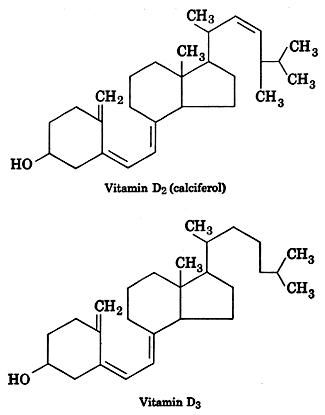
![]()
VITAMIN D
The Nobel Nobel prize for chemistry for 1928 was awarded to Adolf Windaus "for his studies on the constitution of the sterols and their connection with vitamins". The vitamin in question was vitamin D and Windaus was the first scientist to receive an award mentioning vitamins.
A comprehensive review of the vitamin D history viewed through the contribution of Windaus may be found in a paper by Wolf G (J Nutr 2004, 134, 1299).
Vitamin D2 (calciferol) originates from irradiation at about 260nm of ergosterol while vitamin D3 is formed by irradiation of a provitamin molecule (7-dehydrocholesterol) present in the skin and gut lining. From a physiological point of view, Steenbock H et al. discovered the formation of an anti-rachitic factor in rats under UV irradiation (J Biol Chem 1924, 61, 405). Vitamin D3 was isolated around 1936 (Brockmann) from the very potent liver oil of the tuna fish. The unsaponifiable fraction was partitioned between 90% methanol and petroleum ether to separate vitamins A and D. The residue from the petroleum phase contained vitamin D3 to be purified by multiple chromatography. The total synthesis was done around 1952 (Woodward, J Amer Chem Soc, 74, 4223). When tested on rats, the two vitamins are equally potent (vitamin D3 is more active than D2 in the chick test). The international unit has been so defined as 40 i.u./µg. Natural fish liver oils vary from about 100 i.u./g in cod to 200,000 i.u./g in tuna fish.
DeLuca HF (Holick M F et al., Biochemistry 1971, 10, 2799), Norman AW (Biochem Biophys Res Commun 1971, 42, 1082), and Kodicek E (Fraser DR et al., Nature 1970, Nature 228, 764) independently reported the existence of an active metabolite, 1,25-dihydroxyvitamin D3, which was produced in the kidneys. From these observations it was surmised that vitamin D3 was hydroxylated in the liver to become 25-hydroxyvitamin D3, the major circulating form of the vitamin, and then converted to 1,25-dihydroxyvitamin D3 in the kidneys. Thus, this final metabolic product is now considered as the metabolically active form of vitamin D3, which carried out its functions in initiating intestinal calcium transport. As the generation of vitamin D3 by UV-mediated photosynthesis is the main source of this secosteroid compound, it can be considered that vitamin D3 is not a true vitamin but a true hormone.
It has been shown that vitamin D3 is present in plants, especially in species belonging to the family Solanaceae. The first demonstration that Solanum glaucophyllum living in South America is a source of 1,25-dihydroxyvitamin D3 has been done in 1977 (Napoli JL et al., J Biol Chem 1977, 252, 2580). The concentration was estimated to 230 pg/g of tissue. Later, it was demonstrate that grass potentially can be a significant source of vitamin D2 (average content was 2ng/g fresh weight) for grazing animals and animals fed on silage and hay (Japelt RB et al., J Agric Food Chem 2011, 59,10907). Vitamin D3 and its hydroxylated metabolites were isolated from leaves of Solanum glaucophyllum but also of tomato (S. lycopersicum) and bell pepper (Capsicum annuum) (Japelt RB et al., Food Chemistry 2013, 138, 1206). Vitamin D3 and 25-hydroxy vitamin D3 were found in the leaves of all plants after UVB-treatment. S. glaucophyllum had the highest content, 200 ng vitamin D3/g dry weight and 31 ng 25-hydroxy vitamin D3/g dry weight, and was the only plant that also contained 1,25 dihydroxy vitamin D3 in both free (32 ng/g dry weight) and glycosylated form (17 ng/g dry weight).
The foods that are the richest in vitamin D are fatty fish (5-20 microg/100 g) and eggs, with smaler amounts being present iin milk, butter, and some meats. The concentrations in several foods may be found on the French CIQUAL table and on the Australian and New Zealand online searchable NUTTAB data base.
It is now well known that vitamin D is a central player in calcium and bone metabolism, but more recently, important immunomodulatory effects have been attributed to this vitamin (Baeke F et al., Mol Aspects Med 2008, 29, 376). Vitamin D deficiency/insufficiency has been associated with muscle weakness and a high incidence of various chronic diseases such as cardiovascular disease, cancer, multiple sclerosis, and type 1 and 2 diabetes (Zittermann A et al., Nutrients 2010, 2, 408). Most importantly, low vitamin D status has been found to be an independent predictor of all-cause mortality (Zittermann A et al., Curr Opin Clin Nutr Metab Care 2009, 12, 634). A review of the new trends in the physiological actions of vitamin D has been released in 2009 (Dixon KM et al., Int J Biochem Cell Biol 2009, 41, 982) and may be found in my book (Lipids – Nutrition and health, Claude Leray, CRC Press).
Initially, the determination of vitamin D was based on a reaction between antimony trichloride giving a yellow color with l max 500nm.Removal of vitamin A and E was necessary. Partition chromatography is actually used with success.
|
vitamin D2 |
Vitamin D3 |
|
| Molecular weight |
396.6 |
384.6 |
| l max |
265 |
265 |
| Molar extinction coefficient |
18,200 |
18,200 |
| m.p. |
116°C |
83°C |
For humans, the requirements are about 100 i.u./day for a man but 400 i.u./day for a child or a pregnant woman.

The analysis of the vitamin D metabolites is dominated by immunoassays and receptor binding assays but an efficient profiling of major vitamin D metabolites has been described using a Diels-Alder derivatization and ultra-performance liquid chromatography-tandem mass spectrometry (Aronov PA et al., Anal Bioanal Chem 2008, 391, 1917). A review of that approach has been reviewed (Higashi T et al., J Chromatogr B 2010,878, 1654).
Devenez membre et participez au développement de la Lipidomique au XXIème siècle.
S'inscrire